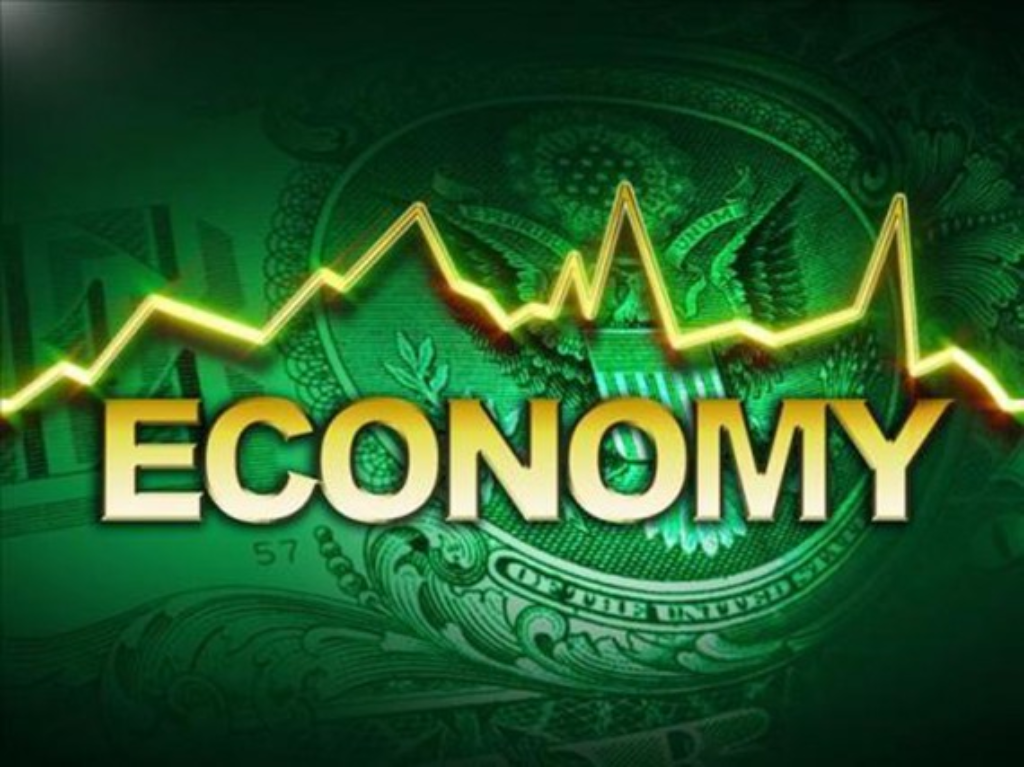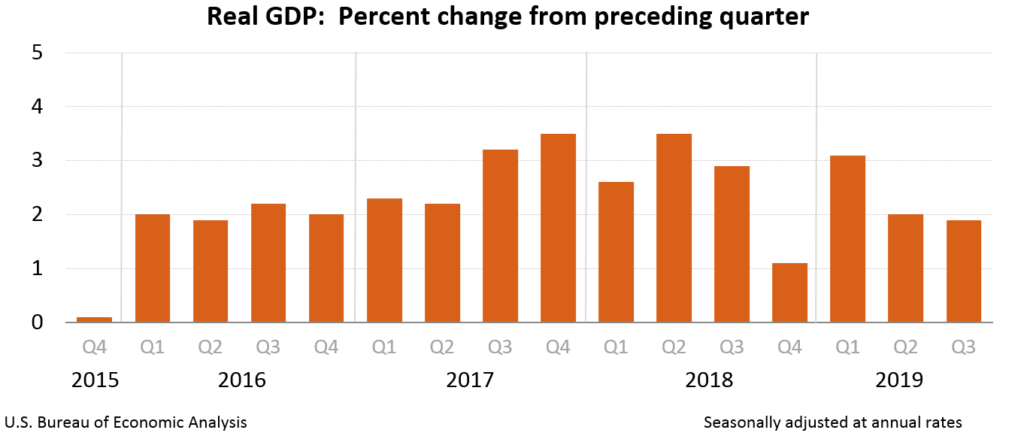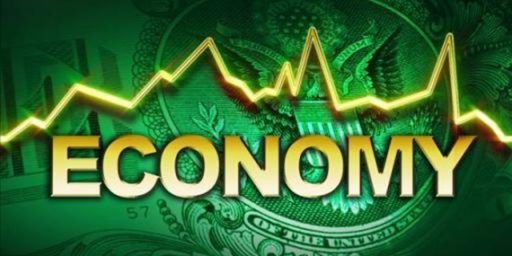Economy Grew At Anemic 1.9% In Third Quarter, Hinting At A Slowdown Ahead
The economy grew an anemic 1.9% in the third quarter according to the first estimate of the state of the economy over the summer.

In a potential sign that the economy is slowing down as we head into 2020 and the 125th month of the economic recovery that began in June 2009, the first estimate of Gross Domestic Product in the just-ended third quarter came in at just 1.9%:
Real gross domestic product (GDP) increased at an annual rate of 1.9 percent in the third quarter of 2019 (table 1), according to the “advance” estimate released by the Bureau of Economic Analysis. In the second quarter, real GDP increased 2.0 percent.
The GDP estimate released today is based on source data that are incomplete or subject to further revision by the source agency (see “Source Data for the Advance Estimate” on page 2). The “second” estimate for the third quarter, based on more complete data, will be released on November 27, 2019.
The increase in real GDP in the third quarter reflected positive contributions from personal consumption expenditures (PCE), federal government spending, residential fixed investment, state and local government spending, and exports that were partly offset by negative contributions from nonresidential fixed investment and private inventory investment. Imports, which are a subtraction in the calculation of GDP, increased (table 2).
The deceleration in real GDP in the third quarter reflected decelerations in PCE, federal government spending, and state and local government spending, and a larger decrease in nonresidential fixed investment.
These movements were partly offset by a smaller decrease in private inventory investment, and upturns in exports and in residential fixed investment.
Current dollar GDP increased 3.5 percent, or $185.6 billion, in the third quarter to a level of $21.53 trillion. In the second quarter, GDP increased 4.7 percent, or $241.4 billion (tables 1 and 3).
The price index for gross domestic purchases increased 1.4 percent in the third quarter, compared with an increase of 2.2 percent in the second quarter (table 4). The PCE price index increased 1.5 percent, compared with an increase of 2.4 percent. Excluding food and energy prices, the PCE price index increased 2.2 percent, compared with an increase of 1.9 percent.
Current-dollar personal income increased $172.8 billion in the third quarter, compared with an increase of $244.2 billion in the second quarter. The deceleration reflected a downturn in personal income receipts on assets and decelerations in compensation and in personal current transfer receipts that were partly offset by an acceleration in proprietors’ income (table 8).
Disposable personal income increased $181.7 billion, or 4.5 percent, in the third quarter, compared with an increase of $192.6 billion, or 4.8 percent, in the second quarter. Real disposable personal income increased 2.9 percent, compared with an increase of 2.4 percent.
Personal saving was $1.34 trillion in the third quarter, compared with $1.32 trillion in the second quarter. The personal saving rate — personal saving as a percentage of disposable personal income — was 8.1 percent in the third quarter, compared with 8.0 percent in the second quarter.
The Washington Post’s summary of the report emphasizes the fact that it shows that business investment has slowed significantly:
The U.S. economy cooled over the summer, growing at a 1.9 percent annualized pace from July through September, the latest sign that the slowdown is deepening.
The data, released Wednesday morning by the Commerce Department, came as economists anticipated slightly weaker growth following President Trump’s decision to dramatically expand his trade war with China in early August. That decision spooked business leaders and deterred them from making major investments during a period of so much uncertainty.
Consumer spending continues to power the economy, but business investment has now contracted for six straight months, falling 3 percent in the third quarter, the biggest drop since the end of 2015. A number of companies have said they are pulling back because of economic uncertainty, particularly related to whether trade rules will be shifting with China and other countries. Spending on both structures and equipment was deeply negative
Slow growth abroad and problems at big employers such as Boeing and General Motors also were a drag on growth. Tens of thousands of workers went on strike at GM in September, halting most production at the company. And Boeing, the U.S.’s largest exporter, remains under pressure after two fatal crashes of its 737 Max jets in the past year.
After revving to 2.9 percent growth in 2018, the U.S. economy appears to be settling into the slower pace that it notched during the final year of the Obama administration. Trump vowed during his presidential campaign that he could boost the economy to around 4 percent growth, a level not seen in years. He has also promised at least 3 percent growth a year, an annual pace he has yet to achieve.
But the consensus view is that the economy is shifting to a lower gear. Still, the sustained pace suggests it is unlikely to dive into a recession anytime soon, unless there is a major shock or the trade war worsens significantly. Low unemployment, rising wages, and high stock prices have helped fuel consumer spending. Higher federal government spending also provided some lift to growth, helping offset the business investment decline.
After a weak second quarter, White House officials predicted a big rebound in the second half of 2019. White House officials believe they are close to big breakthroughs in two separate trade efforts, one with China and another with Canada and Mexico. But most economists predict more subdued growth is here to stay.
Patricia Cohen at The New York Times, meanwhile, calls the number the newest sign of a slowdown:
Dogged by uneasiness over trade frictions and weak global growth, the American economy’s growth inched lower over the summer.
Gross domestic product — the broadest measure of goods and services produced in the economy — grew at a 1.9 percent annual rate for the third quarter, according to preliminary data released by the Commerce Department on Wednesday.
The year started out with a surge, but the pace of growth declined in the spring and again over the period that spanned July, August and September.
The gain was larger than Wall Street analysts had forecast, but policymakers at the Federal Reserve are still expected to end their two days of meetings in Washington on Wednesday afternoon with an announcement that the central bank will again drop its benchmark interest rate, a preventive measure to keep a slowdown from turning into a slide.
Cohen also points out the political consequences of a number like this:
President Trump has repeatedly highlighted the economy’s performance as evidence that his recipe of tax cuts, deregulation and confrontational tactics on trade is working.
The annual growth rate, though, has fallen short of the president’s repeated promise that it would surpass 3 percent, or even 4 percent. In July, the White House predicted that the figure would hit 3.2 percent in 2019, and remain at 3 percent or above for the next five years.
That outlook is far more optimistic than those of the Fed, the Organization for Economic Cooperation and Development and most Wall Street analysts. Most forecasts hover around the 2 percent mark — a rate that many economists consider sustainable over the long haul. Steve Rick, chief economist at CUNA Mutual Group, characterized the 1.9 percent rate as “a nice soft landing” in line with long-term growth trends.
Still, it is a pace that Mr. Trump scorned in his 2016 campaign.
Cohen is correct in that last assessment, but the important factor here is the fact that the President had stated repeatedly throughout the 2016 campaign and repeatedly since becoming President. For example, during the campaign he repeatedly attacked President Obama over the fact that GDP growth under his watch never exceeded an annual rate of 3.0%, and promised that he would do that good and even better. The reality is that we have not seen a full year where the economy grew at 3.0% or above since 2005 and, as we’ve seen actual economic growth under President Trump has been roughly comparable to the same figures under the final four years of President Obama’s term in office.
Which, of course, makes this Trump tweet from 2012 ironic:
Leaving the political arguments to the side, compared to recent quarters, there is a defined and measurable drop-off in growth, which could be an outlier or could be the beginning of a trend that could lead to even slower growth:

As this chart shows, there have been quarters where growth was as slow as it is estimated to have been in the third quarter, or even slower, only to see the economy bounce back in succeeding quarters. While that is certainly possible this time, it’s also worth noting that the hypothesis that we’re looking at the start of a slowdown are all around us.
The most prominent one, of course, is simply the fact that the current recovery is itself so long-lasting. There’s no hard and fast rule that says that we have to enter a recession or slowdown after a certain amount of time, it is also true that economic history since the end of World War II has shown that economic recoveries do not last forever and that the longer a recovery lasts, the more likely it is that the economy will slow down and perhaps even enter a recession. That’s’ why the length of the current recovery is so unusual. With the exception of Australia, which has not seen a recession in twenty years, it’s rare for a developed economy to go this long without some kind of slowdown.
In addition to this, there are a number of external factors that suggest we could be headed toward a period of slower if not negative growth. These include the fact that the global economy itself appears to be slowing down and, like it or not, the American economy is inexorably connected to the state of the world economy. Related to that issue, of course, are the President’s tariffs and the trade war that has resulted, which has had a negative impact on the global economy, the domestic economy, and on financial markets across the globe. Significant economic erosion elsewhere, or upping the ante in the trade war, could have a real economic impact here in the United States.
This date, of course, comes on the eve of several significant events. Later today, the Federal Reserve Board is expected to announce what would be its third interest rate reduction this year. What’s unclear, and what may or may not be revealed in the information that the Fed releases in conjunction with its announcement at 2:00 p.m. Eastern time today, is what we might expect by way of interest rate reductions in the future. The consensus seems to be that the Fed will issue a traditionally opaque report that says that this may well be the last reduction of the year, but that decisions on future reductions will depend on underlying economic data. Additionally, on Friday we’ll get the November jobs report from the Bureau of Labor Statistics. We got our first signal on where that might end up this morning with the release of ADP’s private sector employment report, which showed 125,000 new jobs added in October. With respect to the BLS report, meanwhile, analysts are expecting a far more modest 80,000 jobs created in that report, which comes out Friday morning. All of this will give us a much better idea of where the economy might be headed.



1.9% isn’t all that bad, you note around 2% is regarded as sustainable. But the Fed is expected to cut rates this afternoon. I confess I’m skeptical that cutting the Federal Funds Rate a quarter point from an already low target of 2 to 2.25% to 1.75 to 2 will actually do much. But I guess the Fed’s gotta do what the Fed’s gotta do. Allowing the President’s* bad decisions to sink him would be seen as political, while bailing him out from the consequences of those decisions before a re-election campaign would not be. For reasons I do not understand beyond IOKIYAR.
GREATEST.
ECONOMY.
EVER.
Well at least Trump is making money…
https://www.opensecrets.org/news/2019/10/trump-properties-poli-spending-passes-20m/
2.0% isn’t bad, and it is certainly better than under 1% or a recession.
That being said, slower economic growth generally means smaller government revenues from taxation, which leads to things like higher deficits.
Additionally, watching these statistics is important because of their political implications.
As for the Fed, I honestly believe that the main motivation for the rate cuts is to push back against the impact of Trump’s stupid trade war.
We all need to remember that the $1T tax cut give away to the wealthy and corporations was going to:
Boost household incomes by $4K a year.
Pay for itself.
And create GDP growth in the 3-6% range.
None of these things has happened.
@Daryl and his brother Darryl:
Don’t forget how all that erasure of ‘burdensome regulations’ was going to free up huge amounts of business investment as the Magic Of The Marketplace was unleashed.
It’s almost as if Trump and Republicans don’t have a single fking clue what to do about the economy.
@Michael Reynolds:
Almost?
@Daryl and his brother Darryl:
Well, they do know the part that involves making rich people richer, you have to give them that.
@Daryl and his brother Darryl:
To be fair, if the economy had shrunk by -1.5%, Dennison would still call it the greatest economy ever, and present the Sharpie Report showing 15% growth as proof.
Also…I believe this makes the Debt 106.5% of GDP.
I’m old enough to remember when Republicans would be screaming about that…
Fed cuts rates and predictably the stock market. . . wait a minute, the stock market is laying there like a two-day old carp. Gee, do the masters of the universe not think a rate cut will boost the economy?
Let’s review. Trump reduces regulation: no visible positive economic effect. Trump cuts taxes: stock buybacks and no increase in business investment. Trump harangues the Fed to cut rates: Zip. Trump starts a trade war with China: US balance of trade worsens significantly.
Deficit up. National debt up. Balance of trade worse. Manufacturing employment? Up slightly (nominally, not sure relative to population growth) on a track begun six years before Trump was elected. Net positive effect of Trumpnomics: fck all.
“I’m old enough to remember when Republicans would be screaming about that…
Not to be a smarta*s or anything, but that would have been when Obama was POTUS, 2 1/2 years ago. You dont have to be very old.
Steve
@Daryl and his brother Darryl:
You’re only 10???
@Sleeping Dog:
Agerasia